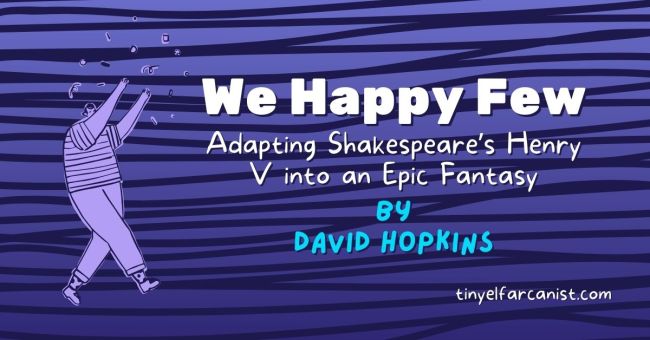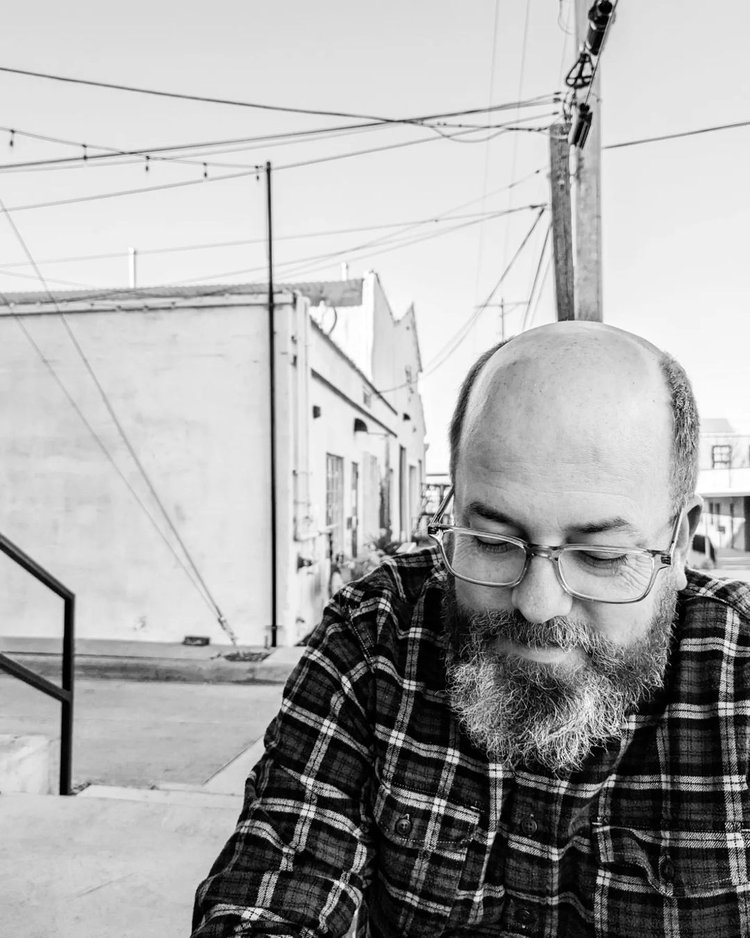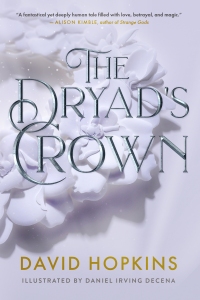David Hopkins talks about the process of adapting Henry V into his own world. War of the Hounds is a prequel to The Dryad’s Crown, one of my favorite reads this year. Before I pass the mic over to David, here’s the cover for the upcoming novella:


Last September, I released my first chonker of a novel, The Dryad’s Crown. It’s book one of a four-part epic fantasy series. The series could extend past that, but we’ll see how I’m holding up. Right now, I’m committing to four chonks. (“Chonk” is an industry term, obviously.) And following the Ryan Cahill indie author strategy for success and happiness, it was time to write my free novella (e.g., Cahill’s The Fall), the one you get when you sign up for my newsletter. I love the idea of writing ancillary novellas, which are published between the main books. They stand alone, which is a great way to bring in new readers who may not want to commit to reading 600+ pages—or want to be thrown into the deep end of lore and worldbuilding. These novellas focus on interesting side characters and provide greater depth to the overall story.
Most importantly, the ancillary novellas—the non-chonks, or what I’m referring to as the “interludes”—are opportunities to experiment creatively without risking the entire series. For example, I’m planning for the second interlude to be an epic poem, written in the style of Shakespeare’s Venus and Adonis, iambic pentameter with an ABABCC rhyming pattern. It will take me at least a year to be even passable with this style of poetry. It’s a bold move. I’m hoping to deliver on something I’m still learning how to do. All in all, it could be “a bad idea.” But these are the kind of risks that make you a better author. And what better place to experiment than in the interludes, the spaces between? Isn’t that where most treasure is hidden?
The first interlude, War of the Hounds, is an adaptation of Shakespeare’s Henry V. It features Bren Caius, cast as the “warlike Harry.” Bren Caius is highly revered, part legend, part celebrity. She was written as Charlemagne meets Alexander the Great meets William the Conqueror with the adoring fanbase of a pop star. In The Dryad’s Crown, Bren is in her twilight years, old glories in the past, and we see someone who has faded a bit. War of the Hounds, which takes place about 30 years earlier, is the story of Bren in her prime. We witness her greatest glory—and we realize the myth doesn’t line up with the reality.
As an adaptation, the story was already written for me. Yes? This should be easy, he said. Adaptations are a breeze, he said. But here’s what I discovered about writing adaptations:
Writing an adaptation means you write twice
Firstly, you’re writing to capture the spirit of the original work. You have to decide on the essentials, which means you have to know the original work backwards and forwards. I’d recommend if you write an adaptation, choose a work from an author who has been dead a long, long time—or even better, use a folktale where the original author is unknown. You won’t insult the author or get sued. (Public domain. Take that, Will.) And you minimize the risk of “getting it wrong.” Critical opinions of Shakespeare’s work, while varied and sometimes at odds with each other, are more or less entrenched. I have a wealth of scholarship to lean on and study. And if I eschew the popular analysis, that’s on me. But you need to know the original and internalize it so deeply that you can write with confidence.
“If adaptations were simply a matter of being faithful to the original, there would be little need for adaptations at all.”
Secondly, you’re writing to tell the story you want to tell. It can be a little tricky, but it’s no less important. If adaptations were simply a matter of being faithful to the original, there would be little need for adaptations at all. The adaptation is also about finding a new context and a new way to express an old story. You—as the author doing the adapting—also need to have something worth saying. For me, War of the Hounds is a story about the larger issue of why Bren isn’t a monarch, and why she doesn’t want to be a monarch. And the story asks the question, “Can a person be good or wise without being brave?” There’s also foreshadowing to a much greater war that’s brewing between the gods and the fey court, but that’s for later in the series.
Why Henry V
My favorite Shakespearean scholar is Emma Smith, an Oxford professor and the author of This Is Shakespeare. (Yes, I have a favorite Shakespearean scholar.) She provides wonderful and accessible analysis. Professor Smith believes Shakespearean’s work is primarily interrogative in nature. It is more concerned with asking a question than answering one. Options are given even weight, leaving it to the audience to consider the questions. According to Smith, the primary question of Henry V: Is our protagonist admirable or deplorable? Smith says it’s like the duck/rabbit optical illusion. You see one or the other, which diminishes the other option. But it’s just not possible to see both. Seeking “middle ground” is not the point. King Henry V cannot be both admirable and deplorable. We are left to consider who he really is without settling for some middle ground.
That’s what I want for Bren Caius in War of the Hounds. She’s a complicated character, frustratingly so at times. Shakespeare provides a great template, and it’s worked well to overlay Bren’s story with Henry V’s story. It’s given me new insight into this character that I may not have otherwise discovered, if I hadn’t written the adaptation.
“Henry V is the O.G. of ‘medieval warfare’ as a genre.”
Studying Henry V
My first experience with Henry V was watching the Kenneth Branagh version in 1989. All those years ago, I remember being completely enamored with the film and Branagh’s exuberant performance. I rented it from Blockbuster multiple times. Henry V is the O.G. of “medieval warfare” as a genre. The rousing pre-battle speeches. The feisty mid-field parley. Soldiers rushing into battle and combat devolving into a chaotic scrum. It’s not the most accurate depiction of medieval combat, but who cares? It’s dramatic and terrifying, and I love it. This film genre, by and large, attempts to show warfare on a large scale and at the personal level, which is really the goal when writing any military epic.
“He knew she was destined for greater things and that he’d only drag her down, so he let her go.”
More recently, I watched the BBC’s Hollow Crown series, which presents the complete Henriad (Richard II, Henry IV, parts 1-2, Henry V, Henry VI, parts 1-3, and RIchard III). It’s my go-to recommendation for people who want to get into Shakespeare. Beautifully acted by some of the best British actors, this BBC series captures the succession intrigue that made Game of Thrones so popular. It’s an ouroboros of sorts. George R.R. Martin was clearly influenced by Shakespeare’s history plays when he wrote A Song of Ice and Fire, which in turn, influences the Shakespearean production of Hollow Crown. I absolutely adored Tom Hiddleston as the bemused Henry and his complicated friendship with Falstaff, played by Simon Russell Beale. These performances motivated me to bring Falstaff into my story as the character Owyn Oldcastle and to recreate the Boar’s Head Tavern as a flashback for Bren Caius, the night before the battle. In this scene, we get the clearest explanation of why Bren is Bren. If Henry must inevitably reject Falstaff, Bren must reject Oldcastle, but in my adaptation it’s because Oldcastle first rejected her. Oldcastle could’ve adopted Bren and given her his family name—but instead, he knew she was destined for greater things and that he’d only drag her down, so he let her go.
The King on Netflix is less Henry V and more a poor reinvention of the Battle of Agincourt. (The archers! The archers were central to the Agincourt victory! Even my novella gets that part right.) It’s still a very entertaining military epic. From this film, I took the emphasis of single combat with each leader fighting in their army’s stead. It’s an idea not found anywhere in the play—or in the historical Battle of Agincourt—but it makes for good drama. What’s most interesting about The King is how it redeems the friendship of Falstaff and King Henry. This Falstaff (Joel Edgerton) is kept around, and he’s more shrewd, more capable, and more sober. His insights provide the key strategy to win the impossible battle. Romeo and Juliet have died a thousand times on stage, Cordelia can never avoid the noose, but somehow this director couldn’t stand the thought of Henry leaving Falstaff behind. Apparently, Shakespeare went too far this time.
Beyond watching numerous versions of the play, my research involved reading Henry V over and over again. Scene by scene, line by line, I studied the script, trying to squeeze what I could from it. Harold Bloom’s analysis in Shakespeare: The Invention of the Human and Isaac Asimov’s Guide to Shakespeare were both invaluable resources.
Important choices and discoveries made
I learned a few things while working through this adaptation. One came from Netflix’s The King. Even though I was critical of it as an adaptation, it did one thing very well: It showed the combat strategy. Before going into the chaos of the final battle, it’s good to show the reader what’s supposed to happen. It creates expectation and allows you to better navigate the narrative of the battle itself. In War of the Hounds, I made sure to not only show Bren’s battle strategy, but also Kret Bonebreaker’s planned response to create some dramatic tension as we wait for everything to fall apart—and wonder how Bren recovers.
“Bren is not a queen, even though she acts like one.
One challenge of the adaptation was the fundamental difference between Henry and Bren. Henry is a king, the son of the usurper. There are many questions on whether or not he’ll be worthy of his father’s crown—and questions about his father’s legitimacy as king, since he stole the crown from Richard II. Henry V uses this war with France to prove his worth. However, Bren is not a queen, even though she acts like one. She has little to prove. Everyone is already aware of her greatness. I needed to find stronger motivation for Bren Caius. It was a matter of raising the stakes. Whereas Henry was invading France and had no reason to be there, other than to assert a historical claim to the region, Bren and her army are literally fighting for the lives of everyone in Amon. Failure would mean death.
Another challenge was that War of the Hounds must set up some events that happen later, which I already wrote, in the Dryad’s Crown. Without spoiling anything, I needed to make sure certain characters were still around for the previous novel, which happens after the events of War of the Hounds. There were plenty of references to the war, and every mention needs to pay off. In the Dryad’s Crown, Speck talks about the memorable single combat between Bren and Kret. Obviously, I needed that scene in War of the Hounds. It’s easier said than done because single combat for the fate of Amon doesn’t make much sense—especially when you have the larger army.
Lastly, all history has its secrets, its surprises. For this novella to move the reader, the story had to have a few twists and turns. Otherwise, why tell it? The appearance of Hild the Tian priestess is a nice surprise that’s never mentioned in the Dryad’s Crown. And of course, the return of Tian (goddess of luck, mischief, and misfortune) plays a larger role in the whole series.
“I’ve written a follow up to the Dryad’s Crown, which builds upon what I’ve already created and exceeds all expectations.”
This novella, the easy, breezy adaptation, one that I thought I could write in about three months—took me a year. This project has given me a newfound respect for adaptations. Was it worth it? Absolutely. I’ve written a follow up to the Dryad’s Crown, which builds upon what I’ve already created and exceeds all expectations. And I’m giving it to the world for free. Even Shakespeare charged 1 penny for the groundlings, and you can enjoy my story in the comfort of your favorite chair. Take that, Will.
Sign up for my newsletter to receive a free ebook of War of the Hounds when it’s released on Tuesday, July 9, 2024.
Check out David’s book
About David Hopkins

David Hopkins is a fantasy novelist with an interest in Shakespeare, medieval history, fairy tales, and myth. He is the author of The Dryad’s Crown, a story set in the vast world of Efre Ousel. David is married to artist and designer, April Hopkins. They have two daughters, Kennedy and Greta, and a dog named Moose.
David is a full member of SFWA (Science Fiction and Fantasy Writers Association) and founder of Cake and Prose. David teaches classes through WritingWorkshops.com. He’s also an instructor for the ArmadilloCon writers workshop in Austin.


Leave a comment